Dutch Grammar A1 B1
Welkom!
Welcome to the Dutch course! Dutch is a Germanic language, with grammar and vocabulary similar to other European languages. You might recognize some words from English as well! Even so, Dutch is a language with grammatical genders. These genders have influence on endings on words, for example.
Gender and Articles
In Dutch, there are three (grammatical) genders: masculine, feminine, and neuter. Each gender has their own definite article (‘the’): both singular masculine and feminine nouns use de and singular neuter nouns use het. For plural nouns, de is always used. The definite articles de and het don’t have very clear rules for when you’re supposed to use which; this will mostly be learning by heart and developing a feeling for it. However, there are some guidelines to help you along:
De words :
1. De is always used for plural nouns.
2. De is always used for professions: de kok (‘the chef’), de leraar (‘the teacher’).
3. De tends to be used for people with an identified gender, such as: de vader
(‘the father’), de dochter (‘the daughter’).
4. De is used for vegetables, fruits, trees and plants, names of mountains, and rivers.
5. Furthermore, de is used for most words ending on -ie, -ij, -heid, -teit, – schap, -tie, -sie, -aar, -eur, -er, and -or.
6. Finally, de is used for written-out numbers and letters: de drie (‘the three’), de a (‘the a’).
Het words :
1. Het is always used for diminutives. Diminutives can be recognised by their suffix; they end in -je, -tje, -etje, -pje , or -mpje .
2. Het is always used for words consisting of two syllables and starting with be-, ge-, ver-, and ont-.
3. Het is always used for verbs used as nouns. When the infinitive form of a verb is used as a noun (e.g. ‘the walking of the dog’), Dutch uses het (het lopen van de hond).
4. Het is always used for languages and names of metals.
5. Het is also used for names of compass points: het noorden (‘the North’).
6. Het is used for names of sports and games: het schaken (‘chess’), het voetbal
(‘football/soccer’).
7. Furthermore, het is used for words ending on -isme and –ment.
Dutch speakers actually never tend to think about the gender of words. Rather than knowing whether a word is originally feminine or masculine, the only distinction that has to be remembered is the difference between the de words and het words. This is because it has grammatical consequences (in terms of possessives, question words, demonstratives, adjectives, and even relative pronouns). This is why when you learn a new noun, it is very important to memorize whether it is a de or het word.
Pronouns
The Dutch pronouns are as follows:
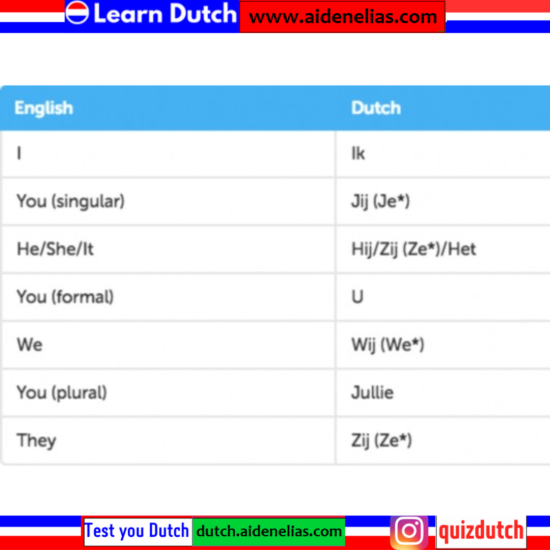
*Je, ze and we are un-emphasized forms of jij, zij and wij. The difference will be taught in another skill.
Verb Conjugation
In Dutch, verbs can be recognised by the ending -en. For example, eten (‘to eat’) and drinken (‘to drink’). Verb conjugation in Dutch can get rather difficult, since there are lots of exceptions (welcome to Dutch, where exceptions are the rule!). The most basic rule is: find the stem and add the right ending to it. To find the stem of the word, you take the infinitive of the word – the basic form that you can find in the dictionary – and take off the ending, i.e. -en. So in the example of ‘drinken’, (to drink), the stem would be drink-. For the simple present, the conjugation is as follows:
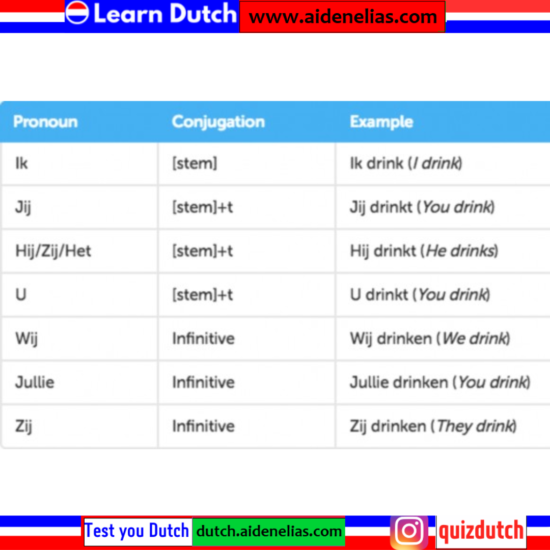
Alphabet
The Dutch alphabet has 26 letters – just like in English. In fact, you don’t have to learn any new letters! Hurrah!
However, there are a lot of differences and peculiarities in pronunciation. Some letters are pronounced differently, and there can be combinations of letters that may throw you for a loop. Don’t worry, we are not discussing the letters just now.
Dutch Grammar A1 B1
Irregular Verbs
In Basics 1 the regular verb conjugations have been explained. Unfortunately, Dutch also has irregular verbs. Fortunately, there are only 6 verbs that are completely irregular. There are more which aren’t entirely regular, but you’ll meet those in the Past tense.
These are the irregular verbs:
1. Hebben (to have)
2. Kunnen (can)
3. Mogen (may)
4. Willen (to want)
5. Zijn (to be)
6. Zullen (shall)
The most common of these are Hebben and Zijn, so here are their conjugations in the present tense:
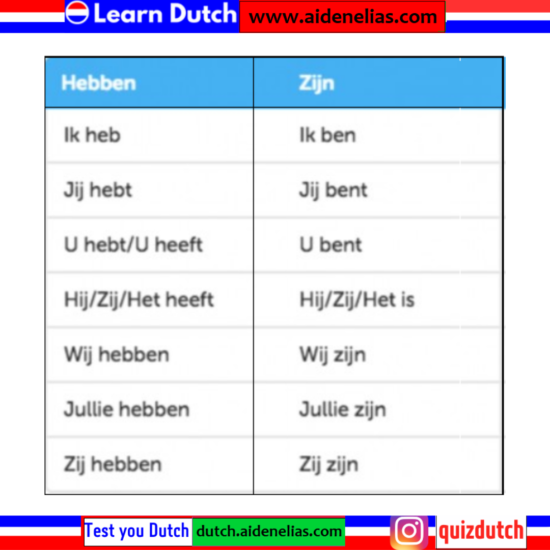
Greetings Throughout The Day
As in English, Dutch has many different ways of greeting others. The most common one, which you can use all day, is Hallo.
An easy way of greeting people throughout the day, is to say the time of day and add goede- “good” in front of it – just like in English. If the time of day starts with a vowel, you squish an -n- in between (an exception being “goeden dag”).
As follows:
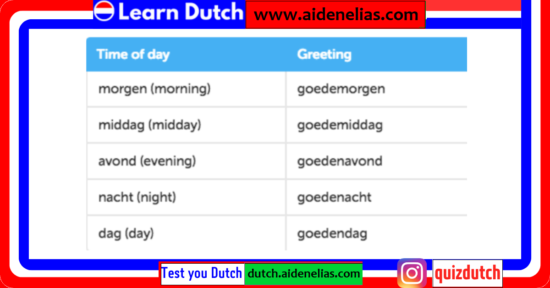
Plurals
Dutch has four ways of making a plural, two of which are very rare. The most common way of making a plural is noun + en.
The second most common way of making a plural is noun + s .
The two rare ways are noun + eren, and plurals ending in -a . That last one is only used for words which come from Latin, and for all of these it’s also correct to just pluralize it with -s .
As with many things in Dutch grammar, the rules for when to use which aren’t very clear. There are some guidelines, but the best way to learn them is by slowly developing a feeling for it.
With that being said, there are a few things to keep in mind:
Noun + En
- Always maintain vowel length. If a vowel sounds long, make sure it keeps sounding long (for instance, schaap becomes schapen). If a vowel sounds short, keep it short for instance, kat becomes katten).
- Hard consonants become soft consonants. If the noun normally ends in an ‘s’ or an ‘f’ (hard consonants), the plural replaces these with a ‘z’ or a ‘v’ respectively. For instance, muis becomes muizen.
Noun + S
- If the noun ends with a single vowel, you cannot just add the -s . Instead, you first add an apostrophe, and then add the -s . For instance, menu becomes menu’s.
- There is an exception to the above rule: words ending with an -e . Those never get the apostrophe.
Dutch Grammar A1 B1
Possessives
The Dutch possessives are as follows:
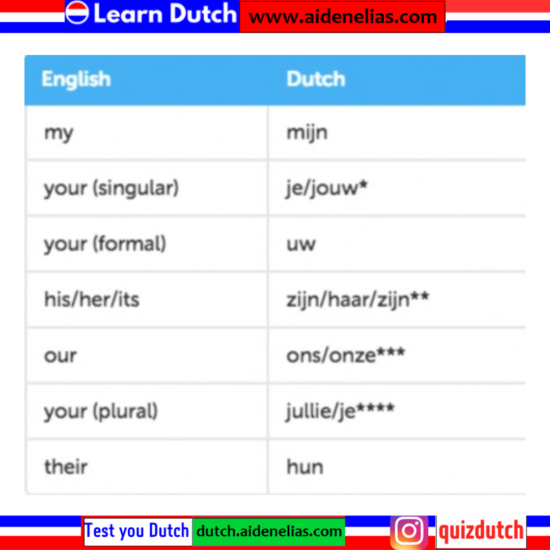
- *If you want to stress that the object is owned by ‘you’, you use jouw.
- **There is no separate possessive pronoun for ‘its’, so we use the masculine zijn.
- ***Whether you use ons or onze depends on the noun. De-nouns get onze, het-nouns get ons.
- ****You use je to avoid saying jullie twice in a row. For example: ‘I give you your books’ – Ik geef jullie jullie boeken – Ik geef jullie je boeken.
Dutch Grammar A1 B1
Independent Possessives
Independent Possessives do not precede a noun. In English they are one word, but in Dutch you need to include de or het. Which of the two you need depends on the noun you are referring to.
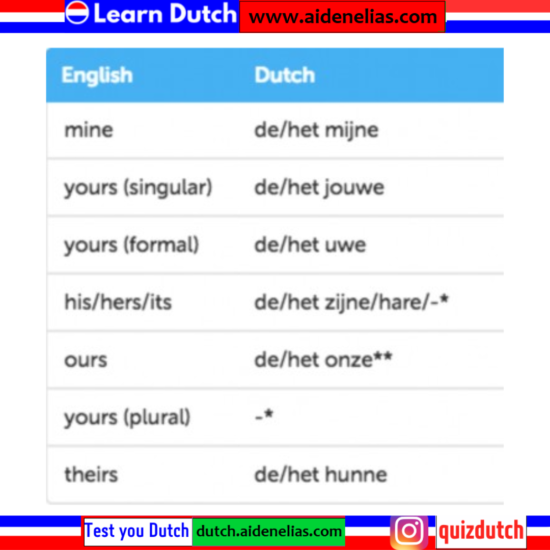
-
*Dutch does not have independent possessives for ‘its’ and plural ‘yours’.
-
**The first person plural independent possessive no longer has the distinction between de- and het-nouns, so it’s always onze.
Dutch Grammar A1 B1
Alternative Possessives
In Dutch, there is another way of saying something belongs to someone, using the word van.
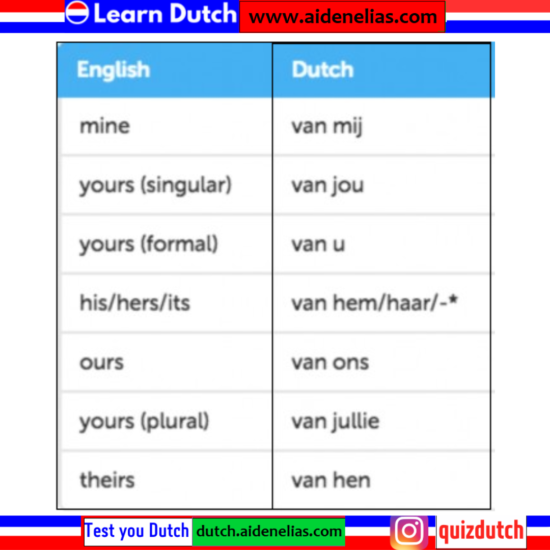
*To indicate something belongs to ‘it’, we say ervan or, with stress, hiervan.
Dutch Grammar A1 B1
Adjectives and Definite Articles
If an adjective comes before a noun with a definite article (“de” or “het”), it usually gets the ending -e .
Singular:
- de grote hond (de hond)
- het grote huis (het huis) Plural:
- de grote honden
- de grote huizen
An -e is also added if there is a demonstrative or possessive pronoun instead of a definite article.
- deze oude hond – this old dog
- dit oude huis – this old house
- mijn oude hond – my old dog
- mijn oude huis – my old house
Adjectives and Indefinite Articles
If the indefinite article ”een” comes before a het-word in the singular, then the adjective does not get the -e ending.
If it comes before a de-word , it does get the ending. Singular:
- een oude hond (de hond)
- een oud huis (het huis)
Plural:
- oude honden (de hond).
- oude huizen (het huis)
The following words act like “een” in that the adjective does not get an ending when preceded by them and if the noun being described is a het-word :
- geen: Dat is geen groot huis. (That is not a big house.)
- elk: Elk zwart pak is duur. (Every black suit is expensive.)
- genoeg: Wij hebben genoeg koud water. (We have enough cold water.)
- ieder: Ieder klein meisje draagt een rok. (Every little girl is wearing a skirt.)
- veel: Ik koop veel lekker bier. (I am buying a lot of tasty beer.)
- wat: Zij eet wat nieuw brood. (She is eating some new bread.)
- weinig: De kinderen eten weinig vers fruit. (The children do not eat much fresh fruit.)
- welk: Welk oud boek leest hij? (Which old book is he reading?)
- zo’n: Dat is zo’n groot dier! (That is such a big animal!)
- zulk: Ze hebben altijd zulk lekker brood. (They always have such tasty bread.)
Adjectives with No Article
If no article at all comes before a het-word , then the adjective does not get the -e ending either.
If no article comes before a de-word , it does get the ending.
- (het) water -> koud water
- (de) koffie -> lekkere koffie
Predicate Adjectives
Put simply, predicate adjectives are adjectives that follow a linking verb like “to be” that describe the subject.
The adjective “green” in “The ball is green.” is a predicate adjective. In Dutch, predicate adjectives don’t get any ending.
- Het huis is groot.
- De hond is groot.
- De honden zijn duur.
Unchanging Adjectives
Some adjectives don’t get any ending. These include:
Adjectives ending in -en (this includes participles of verbs acting as adjectives that end in -en) + eigen: mijn eigen hond (my own dog) + tevreden : de
tevreden katten (the satisfied cats) + gebroken: de gebroken lamp (the broken lamp) + open: het open boek (the open book) + opgewonden: de opgewonden kinderen (the excited children).
Material adjectives with –en:
- gouden: de gouden spiegel (the golden mirror)
- houten: de houten stoel (the wooden chair)
- zilveren: het zilveren kettinkje (the silver necklace) And a few without –en:
- plastic: een plastic zak (a plastic bag)
- rubber : een rubber schoen (a rubber shoe) Adjectives ending in -a or an unstressed –e:
- prima : een prima kans (an excellent opportunity)
- roze : een roze jurk (a pink dress) Adjectives with ordinal numbers in the first part:
- tweedehands : een tweedehands auto (a second-hand car)
- derderangs: derderangs producten (third-rate products) Rechter (right) and linker (left) are not inflected:
- de rechter tafel (the right table)
- de linker foto (the left photo)
NOTE : if the fact that a noun is “left” or “right” is considered a fixed attribute, then “linker” and “rechter” are usually connected to the noun.
- de linkerhand (the left hand)
- de rechterkant (the right side)
A common mistake with the formal ‘you’ in Dutch (u), even amongst native speakers, is to capitalize the u. This should only be reserved for deities. Being polite to others is a very good thing, but addressing them as deities might be a bit too much.
So, write Heeft u een kat?, not Heeft U een kat?
Unless of course you’re asking the deity of your choice whether he/she/it owns a cat.
D, t, dt?
Perhaps the most difficult thing for native Dutch speakers, is to put a -t at the end of a verb at the right time.
Especially when the verb stem ends with a -d , as is the case with houden (the stem is, of course, houd-). You will often hear natives talking about the -dt ending, but in truth this ending does not exist: if you simply follow the conjugation rules it’s just stem + t.
As a refresher, the verb conjugation table for the present:
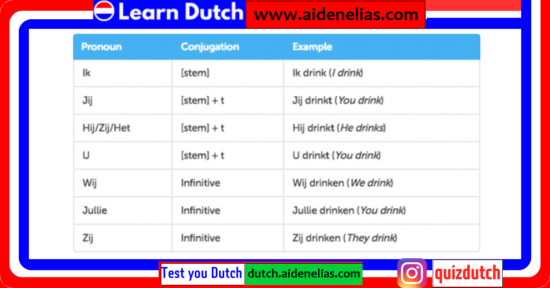
Now let’s replace drinken with houden:
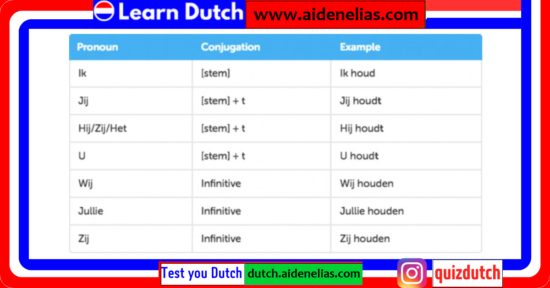
Another difficulty with this arises in sentences which are questions. In particular, the problem-or rather, confusion- is with the second and third person singular, jij and hij. The rules are as follows:
- In a question where the second person singular je/jij is directly after the verb, the verb does not get a –t.
- The third person singular hij/zij/het always gets –t.
So, at first sight you might say Houdt je vader van mij? “Does your father love me?”, is incorrect; after all, je is after the verb, so it should not get a -t. However, je is not the second person singular here; it’s the possessive. The subject, je vader, can be replaced with hij: Houdt hij van mij? and the rule is that the third person singular always gets the -t.
There are some more d/t/dt difficulties in other verb tenses, but those are for another skill!
Dutch has two different object pronoun types: stressed and unstressed. The stressed is used for emphasis. The full table:
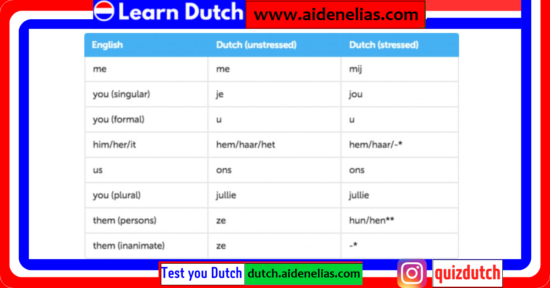
- *For the stressed ‘it’ and inanimate ‘them’, Dutch uses the Demonstrative pronouns, explained in another skill.
- **After a preposition or as the direct object, you use hen. As the indirect object, you use hun. When in doubt, it’s easiest and always correct to use the unstressed ze.
Er vs. (T)here
What On Earth Is ‘Er’?
Er is a weird little word. Sometimes it could be left out of a sentence and it’s still make sense, at other times leaving it out could instantly make it nonsense. Often it’s combined with other words. To a non-Dutch person, er might seem random and all over the place.
- However, there is logic to the seeming randomness of er. The word has five different purposes:
- Expressing location as an unstressed form of daar.
- Replacing hem/het or ze , combining er with a preposition.
- Expressing possession like ‘of it’ or ‘of them’.
- Pointing to an undefined and unspecific subject, putting er at the start of a sentence.
Being used as a subject.
That list might not have cleared up much confusion, so each is explained in a little bit more detail below.
Er As Unstressed Daar
When you want to say ‘there’ but not put stress on it like you would do with
daar, you instead say er.
Examples:
‘I go there.’
Emphasis on ‘there’:
Ik ga daar heen.
No emphasis:
Ik ga er heen.
Replacing Hem/Het Or Ze
Er replaces het, hem and ze (‘them’) when they are preceded by a preposition and they refer to something inanimate. In such a replacement, the preposition gets attached to the end of er.
Example:
- Ik sta erop. (‘I stand on it.’)
Expressing Possession
This type is basically the same as the previous type. When in English you say ‘of it’ or ‘of them’ (as in ‘I have three of them’), you can say ervan in Dutch. However, you can leave off van. Including it isn’t incorrect, but often sounds odd. The example sentence ‘I have three of them’ would thus be Ik heb er drie.
Pointing To An Unspecific Subject
This one is put at the start of sentences. It seems extra, but often isn’t really. Don’t feel bad if you make mistakes with this one; language experts can’t really agree on whether it’s compulsory, and there aren’t really any clear rules for it. It’s more like a feeling. However, there is a guideline:
If the subject is unspecific and undefinded, in other words it could be anyone, you add er at the start of the sentence. For example, ‘Some woman leaves’ would become Er gaat een vrouw weg. ‘Some woman’ could be any woman.
You do not add this er when the subject:
- refers to a general category
- is part of a general statement or rule
- is undefined, but specific
In questions, this er can sometimes be compulsory. This is in the case of interrogative pronouns, like wie, welk, wat. ‘What could happen?’ would become Wat kan er gebeuren?
Er can get more complicated than this, but these are the basics. Good luck!